- Home
- Jane Peart
A Montclair Homecoming Page 2
A Montclair Homecoming Read online
Page 2
He checked his wristwatch. It was time to get up to the meeting. He’d meant to be early enough to do a little lobbying, politicking, among the other members. It would be nice to hear a few compliments as well. He meant to have his voice heard in this selection.
Sylvia Thornton, Dr. Fonteyne’s secretary, tapped lightly on his office door before entering. “It’s almost ten, Doctor.”
Jim Fonteyne shoved his horn-rimmed glasses down his nose and looked at her over them, his expression blank. “Ten?” he repeated.
“The artists for the mural interviews,” she reminded him gently.
“Oh yes, that.” He closed the folder he was perusing at his desk and stood up, a rangy man with iron gray hair, looking younger than his sixty years. He reached for his coat jacket and shrugged his broad shoulders into it. His wife, Lillian, had especially chosen the blue-striped, white-collared shirt and dark blue jacket for him to wear this morning. She always kept track of his appointments, carefully chose the appropriate outfit for whatever he was doing that day, and laid it out for him each morning while he showered.
Sylvia surveyed him critically. She had worked for him for six years and took immense pride in her job with the chief of staff. She understood the prestige of his position. Burdened with the many duties of his work, Jim Fonteyne was careless about himself. That was why his secretary and wife made sure he always looked well put together, well groomed. Dr. Fonteyne knew this and was amused by their contrivance. Now, with a hint of a smile, he asked, “Everything okay, Syl?”
Sylvia nodded and looked on approvingly as he straightened his red paisley tie. Yes, Mrs. Fonteyne would be satisfied.
He walked to the door, then halted and turned back to Sylvia. “Where are we meeting?”
“Conference room, fourth,” she replied.
“Yes, of course. Thanks,” he said and went out the door.
chapter
2
“MISS MONTROSE?”
At the sound of her name Joy involuntarily started. She had been sitting in the hall for what had seemed an endless length of time as the other two artists were interviewed. She turned to see an attractive, gray-haired lady standing in the open door of the conference room. “I’m Clare Morgan, from admissions. Won’t you please come in?”
Joy stood up, clutching her portfolio, and followed her into a large room, where five people were seated at one end of a long table.
Mrs. Morgan made the introductions. “This is Miss Joy Montrose. And this is the mural selection committee: Dr. Jim Fonteyne, our chief of staff; Mr. Glendon McFarland, the architect who designed the new solarium; Sister Mary Hope, of the chaplain’s office; Dr. Jean Braden, whom I believe you know; and Dr. Evan Wallace, chief of surgery.”
All the names and faces blurred except one. The man introduced as Dr. Evan Wallace was the man she had collided with coming out of the elevator in the lobby. But if he had a similar recall, he did not show it by even a flicker in his steel blue eyes.
“Now, Miss Montrose, if you’ll just take your place over there.” Mrs. Morgan indicated a wooden lectern with an easel placed alongside. “The lighting is adjusted so the committee can see your work to its best advantage.”
A wave of panic swept over Joy. Her hands, holding the portfolio, were clammy; her fingers felt numb. Here came the real test. This was it, the defining moment of all the weeks of work. They would either like or hate her paintings.
“Thank you for coming, Miss Montrose,” the distinguished-looking man introduced as Dr. Fonteyne said. “Would you tell us a little about yourself—your background, your art education?”
Joy swallowed. She was an artist, not a speaker. Probably her experience might seem very thin to this group, depending on the other artists who were submitting their work for this commission. Would anyone care that from the time she could hold a crayon, all she had wanted was to be an artist? That she had drawn, colored, and painted all through elementary school, high school, and junior college? That she had won a year’s scholarship to the city’s art institute? Or that currently she worked at Shelton’s Department Store, setting up displays, decorating windows, printing signs, while continuing to take evening classes?
Another panel member, a youthful-looking woman with an eager, interested expression, spoke. “We understand you have done other murals?”
“Yes, Dr. Braden’s office.”
Joy glanced gratefully at Jean, who turned to the others, saying, “I would be happy for the rest of the committee to come and see our waiting room after office hours. Miss Montrose created a carousel on which delightful nursery-rhyme characters ride around the room. We’ve had great response from both our patients and their parents.”
“Any other work you’d like to mention? Specifically, murals that could be seen locally?” This came from Glendon McFarland.
“I’ve worked with a team of students from the art institute on a mural at the Children’s Day Center. That’s where Dr. Braden saw my work and asked me to design a mural for her office.”
“Well, Miss Montrose, perhaps we should see the sketches you’ve brought for us to examine today, and you could explain your theme,” suggested Dr. Wallace.
Did she detect a slight impatience in his tone? Well, she would not let it unnerve her. Saying a silent little prayer, Joy positioned the first of her pictures on the easel. “Since the solarium is pentagon-shaped, with windows between the wall panels, I have chosen to depict five of Christ’s healing miracles. The figure of Jesus would only be seen as a shadow or as light. The people being healed would tell their own stories.”
One after the other she placed her paintings—all rendered in watercolor on eighteen-by-fourteen-inch illustration board—in sequence as she gave their individual titles: “‘Jarius’s Little Daughter,’ ‘The Centurion’s Servant,’ ‘Peter’s Mother-in-Law,’ ‘The Blind Man,’ ‘The Paralytic at the Pool.’”
“Perhaps you could pass them among the members of the committee so that each could have a closer look?” Mrs. Morgan suggested.
“Certainly,” Joy said and gathered them up and handed them to her. As the paintings were passed from one to the other, Joy tried to read some reaction in the individual faces. But it was impossible.
Finally Mrs. Morgan asked, “Does anyone have any further questions for Miss Montrose, or any additional comment he or she would like to make?”
Joy’s stomach tightened as she waited for what seemed a long moment. Then Dr. Wallace spoke. “Miss Montrose, I find your sketches interesting, colorful, and professional. No doubt you have talent and the skill to execute your ideas. My question is, would you be willing, if you were the chosen artist for the mural, to change your theme? In other words, to work out another one? The reason I bring this up is because at this hospital we treat all kinds of people, not only Christians, and I wonder if so explicit a religious theme is suitable or appropriate in a nonsectarian institution.”
A murmur rippled down the table, members looking at each other. Evidently, that question had not occurred to anyone else. It caught Joy completely off guard. She had never expected such an objection. Again with a silent prayer for help, she met Dr. Wallace’s challenging gaze and answered. “Frankly, that possibility hadn’t entered my mind. My theme seemed so…so right somehow.” She paused. “But to answer your question, I think any artist would find it difficult to develop someone else’s concept.” Was she giving up her chance to paint the mural? For a moment she faltered, seeing her great opportunity slip away from her. Then she lifted her chin and added firmly, “However, since the name of this hospital is Good Samaritan, I believe my theme is perfectly in keeping with the spirit of an institution which treats everyone regardless of race, religion, or creed.”
Her gaze swept over the faces of the five people looking at her. All were unreadable except for that of Sister Mary Hope. There seemed to be an affirming twinkle in her eyes, and a smile tugged at her mouth. Joy even thought she saw a flicker of admiration in the eyes of Dr. Wallace.
Amazed at her own boldness, Joy felt a delayed reaction. Her knees suddenly felt as if they were turning to gelatin, and she reached out to steady herself on the lectern.
“Thank you very much, Miss Montrose,” Mrs. Morgan said in a tone that declared the interview at an end. “If you will, kindly leave your portfolio so the committee can examine and discuss your work more thoroughly. You will of course be notified either way when the committee reaches its decision.”
“Of course.”
Joy wasn’t sure just how she managed to get out of the room, to the elevator, and back down to the lobby. The next thing she knew, she was standing outside in the bright autumn sunshine.
Without her portfolio, there was no need for the extravagance of a taxi, so Joy started walking to the nearest bus stop.
She had left nearly six weeks of planning, dreaming, praying, and hard work with a group of five people. Win or lose. She had done all she could. Now her future was in the hands of those five people. At least her ordeal was over. The rest was up to the Lord.
chapter
3
THE NEXT WEEK crawled by. The only way Joy was able to survive the suspense was to plunge herself into her work at the store. Luckily, it kept her very busy. There were several new window displays to set up. This required her going to each department to collect merchandise she needed to feature coordinating shoes, handbags, jewelry, scarves, and accessories. She also had to acquire props for the backgrounds. Since she was only one of three assistants to the display manager, Joy rarely was able to create a whole window completely. She followed the written directions and every once in a while had a chance to add a touch of her own. However, the work was demanding enough to keep her occupied and absorbed during the day.
After work every evening, she raced home to search her mailbox for a letter from the selection committee. She recalled Mrs. Morgan’s cautionary statement that either way the artists would be notified, so her excited anticipation mingled with a feeling of dread. No news is good news, she kept telling herself at the beginning of the second week.
She tried to brace herself for disappointment. Two nights a week she went to her night classes in design at the art institute. She was too shy to tell any of her fellow students that she had submitted sketches for the hospital mural. She had worked on those paintings at home. The sole person she had confided in was Molly Ellis, her only real family. Molly was a distant cousin with whom she had lived after her mother died and her stepfather remarried.
An artist in her own right and a professional calligrapher, Molly had early recognized Joy’s artistic talent and after her graduation from high school had encouraged her to apply to the art institute. She, more than anyone, understood what getting the commission for the mural would mean to Joy.
On Saturday Joy phoned Molly and spilled out her mixed emotions. “I’m afraid I want it too much, Molly,” she said, recounting her doubts about her presentation to the selection committee, and her premonition that Dr. Wallace’s objection to her theme would carry weight.
“Look at it this way, Joy: if it’s in the Lord’s plan for you, you’ll get it. It’s as simple as that. Remember, ‘Be anxious for nothing, but in prayer and thanksgiving make your requests known.’ That’s all there is to it!”
“I wish I felt that confident,” Joy said with a sigh.
“‘Oh, ye of little faith’!” Molly admonished, laughing. To Molly, quoting Scripture came naturally.
“I know you’re right, Molly, and I have dedicated my art to God. I want it to be an inspiration, to bring something special to people who see it. I remember how inspired I felt when John Feight spoke at the art institute. To use my talent for something as worthwhile as he does—painting beautiful, peaceful scenes to help people undergoing chemotherapy—that’s what I thought about all the time I was planning my submission for the mural. To create something by which the families of patients in surgery would be uplifted, to give them hope in the possibility of miracles—” Joy paused. “Now I’m worried that maybe Dr. Wallace’s comment will influence the rest of the committee against my idea. You never know how important one person’s opinion can be.”
“Joy, I know how much you’ve set your heart on this, but if it doesn’t work out, try to remember that when one door closes, another opens.”
“I’ll try, Molly,” Joy said. She hung up, wishing her faith was that strong and simple. It was what gave Molly her serenity. Joy had to work at her own.
A few days later, after a particularly hard day at work, Joy got off the bus at her stop and walked a few blocks further on the tree-lined street of older homes. This had once been an elite residential section of the city, but now most of the mansions had been turned into apartments.
When Joy had first come to the city, she had shared a room at the YWCA while she searched for an apartment where she could paint. Rents were mostly too high for her income. Through a series of strange coincidences Joy found her present home. Actually, it was a water tower.
It was on an old estate whose acreage over the years had been shrunk by subdivision and development. The ownership and destiny of the main house, a huge, many-roomed structure built in the twenties by a man and woman who entertained frequently, was in question. The water tower had been converted to create a hideaway to which the couple could escape when they had too many houseguests. The estate was now tangled in some kind of family litigation. The settlement of the case was pending, awaiting the location of several heirs. The final resolution could be tied up indefinitely. Evidently, no one else had thought the water tower a desirable dwelling place, so Joy had jumped at the very reduced rent.
Located just past the entrance to the property, at the beginning of the long, curving drive up to the house, the water tower was built on three levels and rose up surrounded by arching oak trees. The storybook architecture appealed to Joy’s whimsical nature, and she had never felt convenience to be of particular importance in choosing the perfect place to live. There was an outside staircase that circled up to the first level, which contained a tiny living-dining room and a pocket-size kitchen. On the second level a small bedroom and a tiny bathroom were tucked under the eaves.
It was the third level that had sold Joy on renting the place. It seems that the wife of the original owner had been an amateur artist and had used the top room for a studio. It had a skylight and a tile floor so that paint spills could easily be cleaned.
Joy, who believed nothing happened by chance, had come to consider the “tree house” meant for her. Tonight she was especially looking forward to its cozy refuge as she plodded wearily up the steps.
When she unlocked her door and reached inside to flick on the light switch, she almost missed seeing the long, white envelope marked “Special Delivery” slipped under the front door. She picked it up, saw that the return address was Good Samaritan Hospital. With suddenly shaky hands, she ripped open the flap and unfolded the letter inside.
Dear Miss Montrose:
The mural selection committee of Good Samaritan Hospital is pleased to inform you that you have been awarded the commission…
She got no further before letting out an excited “Yay! Yay!” Spontaneously she did a thumbs-up high-step as she’d seen football players on TV do when they successfully complete a touchdown. She danced all around the tiny apartment and finally settled down to dial Molly’s phone number.
“Oh, Molly, this means I can go to Europe to study art! They’re paying me enough so I can really go! All my dreams are coming true!”
Evidently, Dr. Wallace’s objection to her theme had been overridden by the rest of the committee.
chapter
4
THE FIRST DAY at Good Samaritan reminded Joy of her first day at school, a mixture of excitement and trepidation. Now that she had the commission for the mural, the full extent of what that involved began to hit her. There was so much preparatory work to do before she could begin the actual painting.
The sketches she had su
bmitted for her presentation had been based on drawings she had made of friends, on studies in life classes at the art institute, and on photographs in her files. For the mural panels she would need live models. Where she would go about getting them she wasn’t sure.
How would she find the right models for each of the stories she wanted to illustrate? Professional models would have to be paid. Some might object to coming into a hospital atmosphere. The hospital might object to having nonessential people on the surgical floor, where life-and-death situations were the order of the day. She was sure the hospital administrators wanted the work-in-progress to be as unobtrusive, as nondisruptive to routine, as possible. As Joy turned this problem over in her mind and worried about how she could manage this, she had an idea. An inspiration, actually. Why not use people right on the scene as models? Surely she could find the faces, the figures, the types she was looking for among the staff, the patients, the helpers, the volunteers. They might be willing—even flattered to be asked—to become part of the mural.
Since her first stop that morning was to check in at Dr. Fonteyne’s office, she decided to run the idea by his secretary, Sylvia Thornton, ask her if she thought the chief of staff would have any objection to her plan.
“Why don’t you ask him yourself?” was Sylvia’s answer. She buzzed Dr. Fonteyne on the intercom. “Miss Montrose is here, Doctor. She’d like to speak to you if you have a minute.”
To Joy’s amazement, his response was enthusiastic.
“A splendid idea, Miss Montrose. It will make the mural a hospital project, get everyone personally involved. You certainly have my wholehearted approval.”
Joy thanked him and assured him she would not interrupt anyone’s work or get in the way.
From her desk Sylvia beamed. “If it matters, I think your plan would be great. The project has really sparked the staff’s interest. We’re all thrilled about your ideas for the mural, Miss Montrose.”

 Hero's Bride
Hero's Bride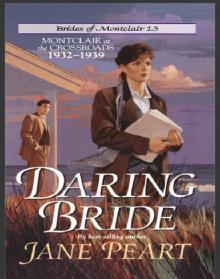 Daring Bride
Daring Bride Runaway Heart
Runaway Heart Promise of the Valley
Promise of the Valley Gallant Bride
Gallant Bride The Pledge, Value
The Pledge, Value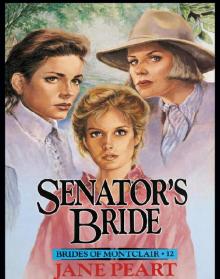 Senator's Bride
Senator's Bride Valiant Bride
Valiant Bride Shadow Bride
Shadow Bride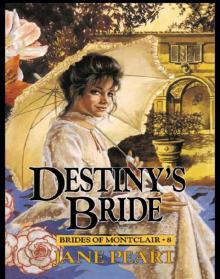 Destiny's Bride
Destiny's Bride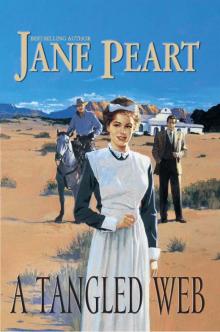 A Tangled Web
A Tangled Web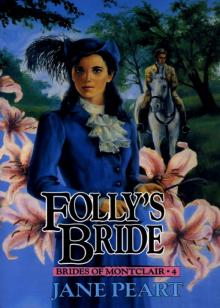 Folly's Bride
Folly's Bride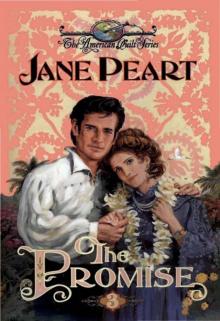 The Promise
The Promise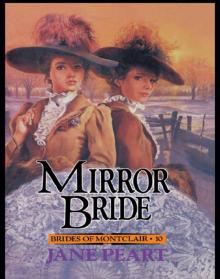 Mirror Bride
Mirror Bride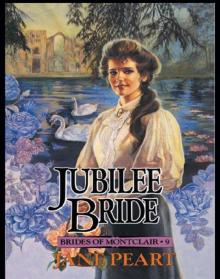 Jubilee Bride
Jubilee Bride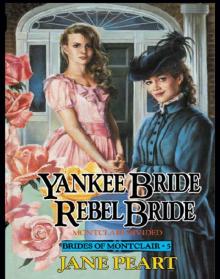 Yankee Bride / Rebel Bride
Yankee Bride / Rebel Bride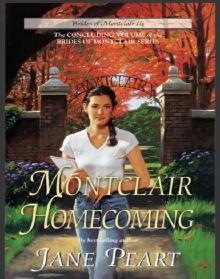 A Montclair Homecoming
A Montclair Homecoming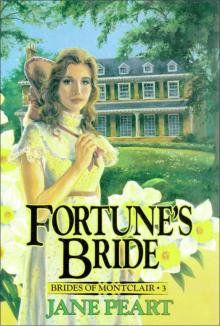 Fortune's Bride
Fortune's Bride Undaunted Spirit
Undaunted Spirit Love Takes Flight
Love Takes Flight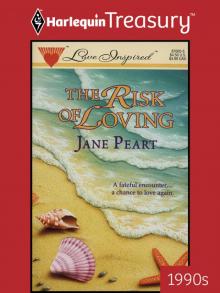 The Risk of Loving
The Risk of Loving The Pattern
The Pattern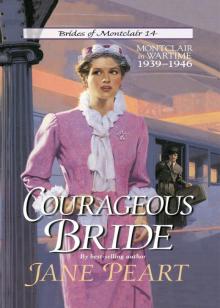 Courageous Bride
Courageous Bride